Modern stromatolites – living fossils
Originating over 3 billion years ago, stromatolites are the oldest known fossils (timeline). Fossilized stromatolites were laid down as colonial structures built by photosynthesizing Cyanobacteria and other microbes. The Cyanobacteria, also called blue-green algae, were responsible for the creation of earth's oxygen atmosphere. These organisms are prokaryotic – cells lacking a cellular nucleus – and thrived in warm aquatic environments, building reefs much as coral does today. Domed columns are typical, and the fossilized structures were quite extensive. Cyanobacteria were the dominant lifeform on Earth for over 2 billion years.
Today stromatolites are nearly extinct, living a precarious existence in only a few localities worldwide – the most famous location is Shark Bay in Western Australia.
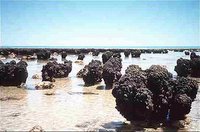 Stromatolites in Shark Bay,
Stromatolites in Shark Bay,  Western Australia – exposed (left) and submerged (right).
Western Australia – exposed (left) and submerged (right).
“At Hamelin Pool in the south of the bay, living microbes still building stromatolites are similar to the earliest life forms which dominated the earth for 3000 million years. Hamelin Pool contains the most diverse and abundant examples of stromatolite forms in the world.” [mod. S]
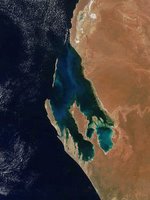 Hamelin Pool is at the southern end of Shark Bay, Western Australia.
Hamelin Pool is at the southern end of Shark Bay, Western Australia.
Low resolution Satellite image of Shark Bay phytoplankton bloom
Full resolution Satellite image of Shark Bay phytoplankton bloom
The extensive Hamelin Pool turf of relict organisms was discovered in 1956. More stromatolites grow in other locations on the ancient shield of western Australia - in the saline Lake Thetis, near Cervantes; in hypersaline lakes on Rottnest Island; in the freshwater Lake Richmond, at Rockingham; and the brackish Lake Clifton, near Mandurah. The link between all Western Australian microbial structures, regardless of the salinity of the water in which they grow, is the presence of calcium carbonate. The source of the calcium carbonate may be groundwater that has passed through lime-rich substrates [Shark Bay Cyanobacteria and Stromatolites]. Map. Western Australia also boasts some of the oldest known examples of stromatolites (3.45 billion years old), occurring as fossils in the Pilbara region between Marble Bar and Port Hedland. Marble Bar stratigraphy stratigraphy-timeline WA microfossils.
More recently, stromatolite colonies have been discovered in locations such as the Bahamas, the Indian Ocean, Yellowstone National Park, and Poza Azul lake at Cuatro Cienegas, Mexico.
______________________________________________
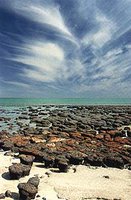 The Hamelin Pool stromatolites in Shark Bay -
The Hamelin Pool stromatolites in Shark Bay - 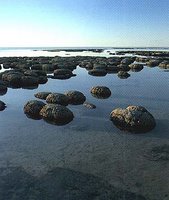 at low (left) and higher tides (right).
at low (left) and higher tides (right).
The water of Hamelin Pool within Shark Bay is twice as saline as typical sea-water because of rapid evaporation from the shallow water, and because a bar across the bay's entrance reduces mixing with normal brine. This hypersaline water is inhospitable to marine browsers, which which otherwise would feed on the bacteria that construct stromatolites. As a result stromatolites can grow undisturbed in Shark Bay. Most stromatolites are extremely slow growing. Those in Hamelin Pool grow at a maximum of .3mm a year. This means that those that are up to a metre high are several thousands of years old.
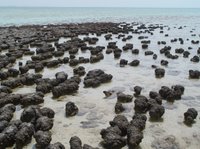
More images of stromatolites of Hamelin Pool (Shark Bay) / stromatolites displaying weathering / partly submerged / partly exposed

Today stromatolites are nearly extinct, living a precarious existence in only a few localities worldwide – the most famous location is Shark Bay in Western Australia.
 Stromatolites in Shark Bay,
Stromatolites in Shark Bay,  Western Australia – exposed (left) and submerged (right).
Western Australia – exposed (left) and submerged (right).“At Hamelin Pool in the south of the bay, living microbes still building stromatolites are similar to the earliest life forms which dominated the earth for 3000 million years. Hamelin Pool contains the most diverse and abundant examples of stromatolite forms in the world.” [mod. S]
 Hamelin Pool is at the southern end of Shark Bay, Western Australia.
Hamelin Pool is at the southern end of Shark Bay, Western Australia.Low resolution Satellite image of Shark Bay phytoplankton bloom
Full resolution Satellite image of Shark Bay phytoplankton bloom
The extensive Hamelin Pool turf of relict organisms was discovered in 1956. More stromatolites grow in other locations on the ancient shield of western Australia - in the saline Lake Thetis, near Cervantes; in hypersaline lakes on Rottnest Island; in the freshwater Lake Richmond, at Rockingham; and the brackish Lake Clifton, near Mandurah. The link between all Western Australian microbial structures, regardless of the salinity of the water in which they grow, is the presence of calcium carbonate. The source of the calcium carbonate may be groundwater that has passed through lime-rich substrates [Shark Bay Cyanobacteria and Stromatolites]. Map. Western Australia also boasts some of the oldest known examples of stromatolites (3.45 billion years old), occurring as fossils in the Pilbara region between Marble Bar and Port Hedland. Marble Bar stratigraphy stratigraphy-timeline WA microfossils.
More recently, stromatolite colonies have been discovered in locations such as the Bahamas, the Indian Ocean, Yellowstone National Park, and Poza Azul lake at Cuatro Cienegas, Mexico.
______________________________________________
 The Hamelin Pool stromatolites in Shark Bay -
The Hamelin Pool stromatolites in Shark Bay -  at low (left) and higher tides (right).
at low (left) and higher tides (right). The water of Hamelin Pool within Shark Bay is twice as saline as typical sea-water because of rapid evaporation from the shallow water, and because a bar across the bay's entrance reduces mixing with normal brine. This hypersaline water is inhospitable to marine browsers, which which otherwise would feed on the bacteria that construct stromatolites. As a result stromatolites can grow undisturbed in Shark Bay. Most stromatolites are extremely slow growing. Those in Hamelin Pool grow at a maximum of .3mm a year. This means that those that are up to a metre high are several thousands of years old.

More images of stromatolites of Hamelin Pool (Shark Bay) / stromatolites displaying weathering / partly submerged / partly exposed
Labels: colonies, Cyanobacteria, fossilized stromatolites, Hamelin Pool, Shark Bay, stromatolites








































